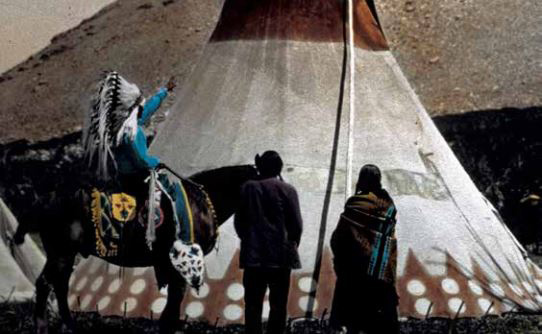Last updated: September 15, 2023
Lesson Plan
Painted Lodges

- Grade Level:
- Middle School: Sixth Grade through Eighth Grade
- Subject:
- Math,Social Studies
- Lesson Duration:
- 60 Minutes
Essential Question
What is the significance of native lodges?
Objective
Students will be able to:
• Discuss difference between cultures with relation to animals.
• Recognize the special significance and variation of painted lodge designs within Indian cultures and discuss why wild animals might be portrayed on a lodge.
• Name the three animals that occur in the traditional Blackfeet, Kootenai, Salish, and Pend d’Oreille stories from the student reading and give a unique characteristic of each of those animals.
Background
This lesson is one part of Work House: A Glacier National Park Science and Indian Education Program. It can be completed as a stand alone lesson or as part of the greater Work House course.
The full Work House Program is available on Glacier National Park's website.
Background information as well as the full lesson plan can be found as a PDF here.
Preparation
- Read the Teacher Preparation/Background information on page 6-7 of Work House Unit 5
- Prepare for two 50 minute periods - one for reading and discussion, one for drawing, writing and presenting. Additional time if making models
- Art & theme paper
- Colored pencils
- Suggested books: People Before the Park by Sally Thompson, Kootenai Culture Committee & Pikunni Traditional Association; Tipi: Home of the Nomadic Buffalo Hunters by Paul Goble; The Tipi: Traditional Native American Shelter by Adolph Hungrywolf
Procedure
- Assign students the reading for unit 4 and use the discussion questions to begin a conversation about how different cultures relate to animals. Do students have pets? Livestock? Are they hunters? Are animals important to them? In what way (s)?
- Play the audio recordings from the Tribes of these animal stories. How does each of the stories relate that animal’s importance to the people?
- With the background information provided and any other you might want to add (with respect to American Indian culture about tipis) have each child draw a lodge with a design that depicts a place or an animal of special importance to them. They should use symbolic designs to represent the animals. Remind students not to copy an actual tipi design since they are considered sacred by many tribal members. (Optional: challenge for older students is to have them do the math to create their tipis to scale and then add designs.)
Writing Extension
When the students have finished their drawings, have them write short essays explaining the significance of the personal symbols they have included on their lodges.
Field Trip Extension
- Some students may be interested enough in this idea to build a threedimensional diorama, putting tipis and other kinds of lodging in a natural setting. It would be interesting to see local topographical features and indigenous plants and animals included.
- Many schools have purchased their own tipis and put them up at their schools.
- Visit a tribal business or organization that uses tipis and can give students a demonstration of tipi etiquette and other information.
- Glacier Institute - geology and other education programs.
- Guided Tours in Glacier National Park- various concession operated.
- Flathead Community of Resource Educators (CORE) - outdoor education guide for field trips in the Flathead Region.
- Family Forestry Expo and River Honoring - organized annually, target specific grades and include information about wildlife.
Vocabulary
Maltese Cross, Medicine Lodge, pigments, Plains Culture, Plateau Culture, protocol, symbols, tipi.
Assessment Materials
Encourage the students to show and explain their lodges to the rest of the class. If students are willing, collect the pictures and essays, put them into a binder or book to share. Could they make a school-wide display? Could they compare and contrast tipi design and construction in the past with modern tipis? Other tent/shelter designs used today? How have the materials changed and why?
Additional Resources
- Contact the tribes for speakers or more opportunities to learn about tipis and shelters. Salish -Pend d’Oreille Culture Committee- Phone: (406) 745- 4572. Kootenai Culture Committee - Phone: (406) 849-5541. Blackfeet Community College Cultural and Language Division - Phone (406) 338- 5441.
- Hands on History Footlockers, MT Historical Society, especially pertinent are the “Land of Many Stories” Footlocker - about Glacier NP with 4th grade lessons on mapping, place names, and art. Also the “Lifeways of Montana’s First People” - has a trading activity that highlights the importance of beaver pelts.
